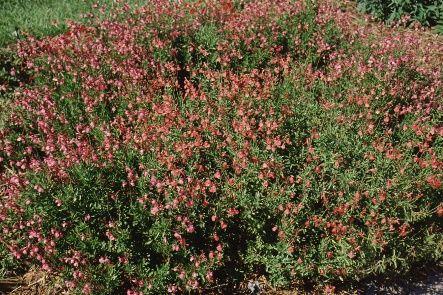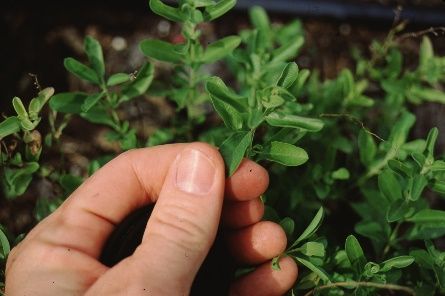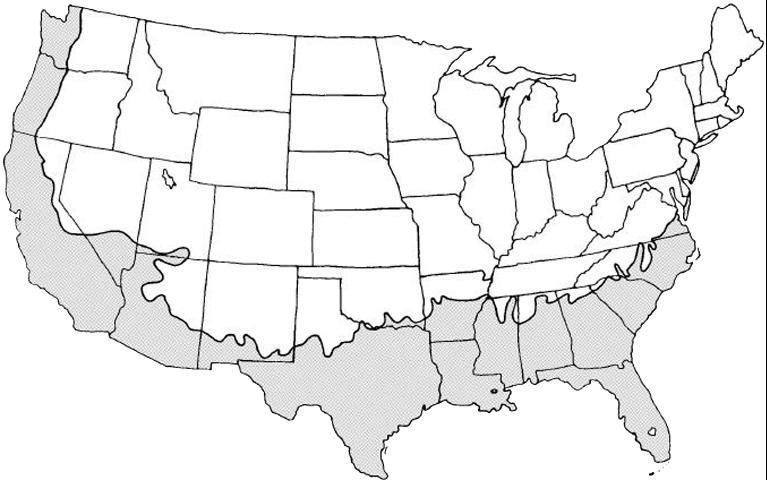Introduction
Like many other salvias, this charming perennial is native to south and west Texas and grows into New Mexico and Mexico. Cherry sage generally attains a height of 6 to 18 inches and blooms from spring to frost. Cherry sage is upright in habit and has dark green, fine-textured leaves. The tubular flowers of this plant come in colors of pink, red, white, salmon, and coral. Plants with red flowers appear in the trade most often. These blooms are very attractive to hummingbirds. The small, red flowers are borne above the foliage but blend in with the leaves due to the open habit of the species. Cultivars have been selected with a tighter canopy.

Credit: Edward F. Gilman, UF/IFAS

Credit: Edward F. Gilman, UF/IFAS
General Information
Scientific name: Salvia greggii
Pronunciation: SAL-vee-uh GREGG-ee-eye
Common name(s): cherry sage, autumn sage, cherry salvia
Family: Lamiaceae
Plant type: perennial; herbaceous
USDA hardiness zones: 7B through 11 (Figure 3)
Planting month for zone 7: Jun; Jul
Planting month for zone 8: May; Jun; Jul; Aug; Sep
Planting month for zone 9: Apr; May; Jun; Jul; Aug; Sep; Oct
Planting month for zone 10 and 11: Feb; Mar; Apr; May; Jun; Jul; Aug; Sep; Oct; Nov; Dec
Origin: native to North America
Invasive potential: not known to be invasive
Uses: cut flowers; border; edging; mass planting; attracts butterflies; attracts hummingbirds; hanging basket; cascading down a wall
Availability: generally available in many areas within its hardiness range

Credit:
Description
Height: 1 to 2 feet
Spread: 1 to 2 feet
Plant habit: round
Plant density: moderate
Growth rate: moderate
Texture: fine
Foliage
Leaf arrangement: opposite/subopposite
Leaf type: simple
Leaf margin: entire
Leaf shape: elliptic (oval)
Leaf venation: pinnate; brachidodrome
Leaf type and persistence: semi-evergreen
Leaf blade length: less than 2 inches
Leaf color: green
Fall color: not applicable
Fall characteristic: not applicable
Flower
Flower color: pink; salmon; white; red; coral
Flower characteristic: summer flowering; fall flowering; spring flowering; flower season is longer in zones 9-11
Fruit
Fruit shape: unknown
Fruit length: unknown
Fruit cover: unknown
Fruit color: unknown
Fruit characteristic: inconspicuous and not showy
Trunk and Branches
Trunk/bark/branches: typically multi-trunked or clumping stems
Current year stem/twig color: reddish
Current year stem/twig thickness: thin
Culture
Light requirement: plant grows in part shade/part sun
Soil tolerances: acidic; alkaline; sand; loam; clay
Drought tolerance: moderate
Soil salt tolerances: unknown
Plant spacing: 18 to 24 inches
Other
Roots: not applicable
Winter interest: no special winter interest
Outstanding plant: plant has outstanding ornamental features and could be planted more
Pest resistance: long-term health usually not affected by pests
Use and Management
Cherry sage may be used as an edging plant and is quite lovely when massed together in large groups. Large beds of cherry sage make a splendid addition to any sunny landscape.
Grow cherry sage in full sun to partial shade. Some shade is preferred in the warmest climates. It prefers well-drained soils and cannot tolerate excessive moisture. However, drought tolerance is good, and plants usually come back the following year if the ground has not been disturbed. Freezing temperatures in the warmer parts of hardiness zone 8 usually do not kill the plant to the ground. The plant is treated as an annual in zone 7 and colder regions.
The cultivar 'Variegata' (desert blaze salvia) has creamy-white leaf margins. It is patented and trademarked.
Propagate cherry sage by cuttings.
Pests and Diseases
No pests or diseases are of major concern.
Aphids will occasionally infest the foliage.